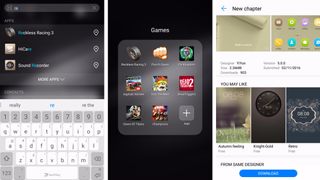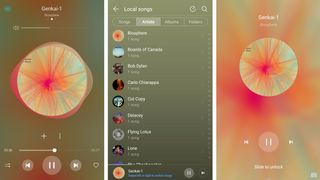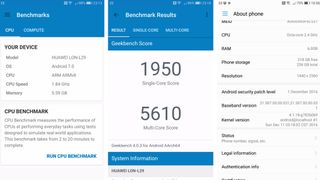Why you can trust TechRadar
Interface and reliability
- Emotion 5 UI over Android 7.0 Nougat
- New UI is improved over previous versions, but still ugly
Huawei has made solid Android phones for a while now. What’s usually the problem is its software - and unfortunately that’s still the case with the Huawei Mate 9 Porsche Design.
The phone is running Android 7.0 Nougat, which is the latest major version of Google’s mobile operating system, but it’s covered with a thick layer of Huawei’s controversial Emotion UI.
Version 5.0 is a lot lighter than previous attempts, but it’s still a retrograde step from stock Android, and it’s arguably less cohesive and attractive than Samsung’s TouchWiz or HTC’s Sense.
There’s still no app drawer here, which some regular Android users may find weird. In practice, it’s no great loss, as you can drag apps into folders on the home screen, and search for them by dragging down from the middle of the screen.

Another plus over previous versions of Emotion UI is the notification menu, which has been cleaned up a fair amount. It now operates on a single plane, which makes your notifications and toggles feel a lot more accessible - and closer to stock Android.
In a similar way, the multitasking menu has switched to a familiar vertically stacked card system, which we found easier to navigate than before.
Huawei still goes heavy on customizing the appearance of your home screens in Emotion UI. There’s a sizeable range of custom themes, all accessible through a dedicated Themes app. Downloading and selecting one will change the whole palette and even the appearance of native app icons.
You can also tweak the basic look of the home screen, including the number of apps on display and the home screen transition animations. It’s possible to toggle whether you want the home screens to scroll around in an endless loop, or where you want apps to auto-align when you delete one of their number.
There are no screen-edge UI tricks here to capitalize on those curved edges, as there are with the Samsung Galaxy S7 Edge and the BlackBerry Priv. The curves aren’t as pronounced, so such functionality makes a little less sense, but some may see it as a missed opportunity.
As well as being relatively customizable, the Emotion UI is quite fluid. We never experienced any real stutters or pauses when navigating through the phone’s menus. It’s very usable, in its own way.

But Emotion UI is just fundamentally less attractive, cohesive and appealing to use than stock Android or iOS. It feels every inch the busy UI it is, rather than a distinct and streamlined operating system, and that disconnect runs counter to the flow of the sophisticated hardware.
Again, we can’t help but think that the Huawei Mate 9 Porsche Design - crazy, limited edition one-off that it is - would have been better served with a stock version of Android 7.0 Nougat. It would have been like an unofficial follow-up to the Nexus 6P, and would have given the phone another crucial distinguishing feature over its rivals (aside from the Google Pixel XL and the Moto Z).
As it is, any incentive the phone’s hardware might possibly give to spend £1200/$1500/AU$2000 on it is at least partially negated by sub-par software.
Movies, music and gaming
- Display renders video and games brilliantly
- Games run flawlessly
- Ample storage for local content
One thing you would expect - demand, even - from such a luxury phone is that it be able to handle media perfectly. The Huawei Mate 9 Porsche Design doesn’t disappoint in this regard.
Its 5.5-inch display is a brilliant canvas for video content. That QHD resolution means that a decent source (such as some of the UHD test footage on YouTube) will render with stunning detail, but it’s the AMOLED panel technology that really makes things pop.

We’re talking extremely deep colors and inky blacks, without everything appearing too false.
Huawei has included its usual dedicated Video app for downloaded video content. This is a fairly basic app, but it includes a few neat features such as a precise scrubbing bar for getting to the exact moment you want, and a screen-in-screen function if you want to continue watching while you do something else in the background.
The Mate 9 Porsche Design’s rich display also pays off when it comes to gaming, which benefits hugely from the size and quality of the screen. This also brings the phone’s processor and RAM into play.

We were able to bump the graphics settings right up to max in the likes of Dead Trigger 2 and Reckless Racing 3, and the phone handled it without a stutter. In the latter’s case, that meant an increase in demanding particle effects and a forced 60fps mode, but we couldn’t detect any hitches.
Both video and gaming benefit from the Mate 9 Porsche Design’s stereo speakers. There’s one on the bottom edge of the phone and one in the earpiece, much like the iPhone 7, and the sound seems slightly weighted towards the bottom unit. Still, it makes for a more rounded sound than most mono-speaker setups we’ve used.
In addition to the aforementioned Video app, Huawei has also included its own Music app for local audio content. It’s functional, and has a vaguely iOS-like feeling to it in its menus and assorted shortcut widgets.

The sound quality is rich here, with built-in DTS giving the sound a more pronounced, bassy feel. Some may object to such audio manipulation, but there’s no doubting that it gives certain music - such as deeply textured electronica - an extra fizz.
When you’re talking about all of this local content, the Huawei Mate 9 Porsche Design has one final trump card - 256GB of internal storage. There’s no microSD card slot, and quite frankly there doesn’t need to be. That’s a massive amount.
It also serves to further erode the impact of that steep price tag. After all, specifying the same amount of storage for the iPhone 7 Plus will bump the price up to $929/£919/AU$1569 - still a lot less than the price of the Huawei Mate 9 Porsche Design, but far closer.
Specs and benchmark performance
- Kirin 960 chipset is a capable performer
- Generous 6GB of RAM
Back when Huawei first launched the Huawei Mate 9, it announced it as “the most powerful smartphone in the world,” and while we didn’t find this to be strictly true according to our own test parameters, it was certainly a very capable performer. The Huawei Mate 9 Porsche Design is similarly strong.
That’s because it uses the exact same Kirin 960 chipset, which is the latest and fastest chip in Huawei’s own fleet of mobile processors. It’s an octa-core SoC that uses four of ARM’s speedy Cortex-A73 cores and four low-powered A53 cores, complete with a fast Mali G71 MP8 GPU.
The key difference between the Mate 9 and its high-class brother is that the Porsche Design comes with 6GB of RAM, which is 50% more.

Of course, the more expensive phone also has a lot more pixels to drive on that QHD display, so you’d expect that advantage to be nullified somewhat.
That seems to be the case based on our own benchmark tests. An average Geekbench 4 multi-core score of 5505 puts it a little below the plain Huawei Mate 9 on 5815. It’s also significantly behind the Samsung Galaxy S7 on 6542.
In real world terms, however, the Huawei Mate 9 Porsche Design is a top-class performer. We didn’t detect any performance hitches when booting up apps, and as mentioned in the previous section it eats high-end games for breakfast.
We booted up Oz: Broken Kingdom and cranked the graphics settings right up to max, yet it performed admirably. This was the game used to show off the iPhone 7’s graphical prowess at launch, remember.
Current page: What's it like to use?
Prev Page Introduction, key features and design Next Page Battery life and camera
